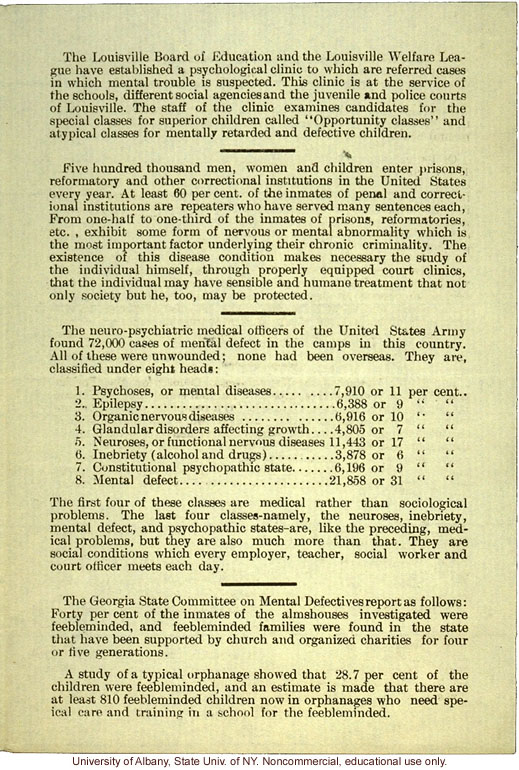"Indiana Society for Mental Hygiene Bulletin No. 7" (July 1920), statistics on mental illness and feeblemindedness in institutions around the U.S. (2)

"Indiana Society for Mental Hygiene Bulletin No. 7" (July 1920), statistics on mental illness and feeblemindedness in institutions around the U.S. (2)
1422. The Louisville Board of Education and the Louisville Welfare League have established a psychological clinic to which are referred cases in which mental trouble is suspected. This clinic is at the service of the schools, different social agencies and the juvenile and police courts of Louisville. The staff of the clinic examines candidates for the special classes for superior children called "Opportunity classes" and atypical classes for mentally retarded and defective children. [centered score] Five hundred thousand men, women and children enter prisons, reformatory and other correctional institutions in the United States every year. At least 60 per cent. of the inmates of penal and correctional institutions are repeaters who have served many sentences each, From one-half to one-third of the inmates of prisons, reformatories, etc., exhibit some form of nervous or mental abnormality which is the most important factor underlying their chronic criminality. The existence of this disease condition makes necessary the study of the individual himself, through properly equipped court clinics, that the individual may have sensible and humane treatment that not only society but he, too, may be protected. [centered score] The neuro-psychiatric medical officers of the United States Army found 72,000 cases of mental defect in the camps in this country. All of these were unwounded; none had been overseas. They are, classified under eight heads: 1. Psychoses, or mental diseases . . .7,910 or 11 per cent.. 2. Epilepsy . . .6,388 or 9 " " 3. Organic nervous diseases . . .6,916 or 10 " " 4. Glandular disorders affecting growth . . . 4,805 or 7 " " 5. Neuroses, or functional nervous diseases . . .11,443 or 17 " " 6. Inebriety (alcohol and drugs) . . .3,878 or 6 " " 7. Constitutional psychopathic state . . .6,196 or 9 " " 8. Mental defect . . .21,858 or 31 " " The first four of these classes are medical rather than sociological problems. The last four classes - namely, the neuroses, inebriety, mental defect, and psychopathic states -- are, like the preceding, medical problems, but they are also much more than that. They are social conditions which every employer, teacher, social worker and court officer meets each day. [centered score] The Georgia State Committee on Mental Defectives report as follows: Forty per cent of the inmates of the almshouses investigated were feebleminded, and feebleminded families were found in the state that have been supported by the church and organized charities for four or five generations. A study of a typical orphanage showed that 28.7 per cent of the children were feebleminded, and an estimate is made that there are at least 810 feebleminded children now in orphanages who need special care and training in a school for the feebleminded. [end]
- ID: 11385
- Source: DNALC.EA


